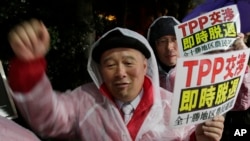Cambodian officials say they are considering joining the US-led Trans-Pacific Partnership, but analysts say the country is a long way from being a part of the regional trade pact.
Prime Minister Hun Sen is preparing for a US visit later this month, where he will meet with other Asean leaders and US President Barack Obama, to discuss trade and security issues.
The US is making major overtures to Southeast Asian countries, as it seeks to counter China’s influence in the region. So far, four Asean members—Brunei, Malaysia, Singapore and Vietnam—have joined the 12-nation TPP. Brunei, Malaysia and Vietnam—as well as the Philippines—all have contentious overlapping claims with China over the South China Sea.
Foreign Ministry spokesman Chum Sounry told VOA Khmer that relevant ministries are studying the possibility of joining the pact. During his visit last week, US Secretary of State John Kerry welcomed Cambodia’s interest in the pact, Chum Sounry said.
It is unclear exactly how Cambodia would benefit from the trade deal, which lowers tariffs on agricultural and industrial goods between its adherents.
Ou Virak, head of the think tank Future Forum, told VOA Khmer that Cambodia should not rush into the pact, the study of which could take two to three years. Still, Cambodia should show interest in it, he said, even as it continues strong ties with China. “Until we depend on no nation, we are at risk of becoming their tool,” he said.
The TPP will not bring that kind of independence, he said, but it would boost exports and revenue, helping the budget away from dependence on other countries.
More immediately, the trade deal could become a part of talks over the South China Sea, which will be discussed at the US-Asean meeting this month. Analysts say the TPP could be a tool through which the US helps its allies in Asia.
Chap Sotharith, senior economic researcher at the Cambodian Institute for Cooperation and Peace, said Cambodia could sign onto the TPP, but it would have to express clearly its own interests, versus the interests of the Asean members who are in disputes with China.
“We are a neutral nation that is not inclined to any party,” he said. “We are not concerned by any dispute with any major power. However, the major advantage for Cambodia is strengthening its foreign relations, especially in terms of trade and investment.”
Now may not be the time to sign onto the TPP, with so much happening in regional politics, he said. A better time frame would be five to 10 years from now, and only after it has joined the Asia-Pacific Economic Cooperation, which US and China are both a part of, he said.
“If we take part, we will gain a lot,” he said. That includes markets to South America, as well as the US, without tariffs, for Cambodian agriculture, especially rice, he said. “If we take part, our goal to export 1 million tons of rice can be reached easily,” he added.
Before his departure to China on Wednesday, Foreign Minister Hor Namhong told VOA Khmer that Cambodia, as well as other Asean members, will strengthen ties with the US during the summit this month in California. He did not, however, discuss the TPP.
“There will be steps forward for friendship, strategic partnership and trade ties with the US,” he said, “because we have to do our best to move Asean forward for the people of the 10 Asean member countries, which have more than 600 million people today.”







